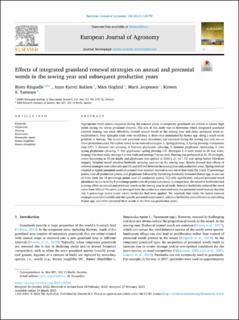| dc.contributor.author | Ringselle, Björn | |
| dc.contributor.author | Bakken, Anne Kjersti | |
| dc.contributor.author | Höglind, Mats | |
| dc.contributor.author | Jørgensen, Marit | |
| dc.contributor.author | Tørresen, Kirsten | |
| dc.date.accessioned | 2023-09-27T12:09:56Z | |
| dc.date.available | 2023-09-27T12:09:56Z | |
| dc.date.created | 2023-04-02T13:28:42Z | |
| dc.date.issued | 2023-03-14 | |
| dc.identifier.citation | European Journal of Agronomy. 2023, 146 . | en_US |
| dc.identifier.issn | 1161-0301 | |
| dc.identifier.uri | https://hdl.handle.net/11250/3092411 | |
| dc.description.abstract | Appropriate weed control measures during the renewal phase of temporary grasslands are critical to ensure high yields during the whole grassland lifecycle. The aim of this study was to determine which integrated grassland renewal strategy can most effectively control annual weeds in the sowing year and delay perennial weed re-establishment. Four split-plot trials were established at three sites dominated by Rumex spp. along a south-north gradient in Norway. The annual and perennial weed abundance was recorded during the sowing year and two or three production years. Main plots tested seven renewal strategies: 1. Spring plowing, 2. Spring plowing+companion crop (CC), 3. Summer cut+plowing, 4. Summer glyphosate+plowing, 5. Summer glyphosate+harrowing, 6. Late spring glyphosate+plowing, 7. Fall glyphosate+spring plowing+CC. Strategies 1–4 were tested in all four trials, strategy 5 in three trials, strategy 6 in two trials and strategy 7 in one trial. Plowing was performed at 20–25 cm depth, rotary harrowing at 15 cm depth, and glyphosate was applied at 2160 g a.i. ha-1. CC was spring barley (Hordeum vulgare). Subplots tested selective herbicide spraying (yes/no) in the sowing year. Results showed that effects of renewal strategies were often site-specific and differed between the sowing year and production years. Spring renewal resulted in higher perennial weed abundance than summer renewal in two out of four trials (by 3 and 12 percentage points, over all production years), and glyphosate followed by harrowing drastically increased Rumex spp. in one out of three trials (by 18 percentage points over all production years). CCs only significantly reduced perennial weed abundance in one trial (by 8 percentage points over all production years). In comparison, the selective herbicides had a strong effect on annual and perennial weeds in the sowing year in all trials. Selective herbicides reduced the weed cover from 32% to 7% cover, and averaged over the production years and sites, the perennial weed biomass fraction was 6 percentage points lower where herbicides had been applied. We conclude that while the tested renewal strategies provided variable and site-specific perennial weed control, selective herbicides were effective at controlling Rumex spp. and other perennial dicot weeds in the first two production years. | en_US |
| dc.language.iso | eng | en_US |
| dc.publisher | Elsevier B.V. | en_US |
| dc.rights | Navngivelse 4.0 Internasjonal | * |
| dc.rights.uri | http://creativecommons.org/licenses/by/4.0/deed.no | * |
| dc.title | Effects of integrated grassland renewal strategies on annual and perennial weeds in the sowing year and subsequent production years | en_US |
| dc.title.alternative | Effects of integrated grassland renewal strategies on annual and perennial weeds in the sowing year and subsequent production years | en_US |
| dc.type | Peer reviewed | en_US |
| dc.type | Journal article | en_US |
| dc.description.version | publishedVersion | en_US |
| dc.rights.holder | © 2023 The Author(s) | en_US |
| dc.source.pagenumber | 11 | en_US |
| dc.source.volume | 146 | en_US |
| dc.source.journal | European Journal of Agronomy | en_US |
| dc.identifier.doi | 10.1016/j.eja.2023.126799 | |
| dc.identifier.cristin | 2139111 | |
| dc.relation.project | Norges forskningsråd: 233637 | en_US |
| dc.source.articlenumber | 126799 | en_US |
| cristin.ispublished | true | |
| cristin.fulltext | original | |
| cristin.qualitycode | 2 | |

